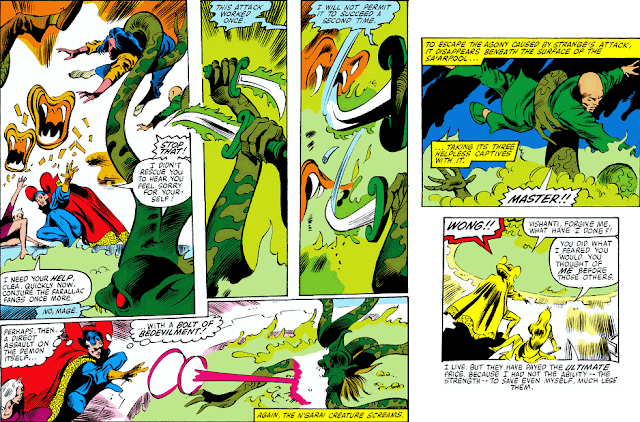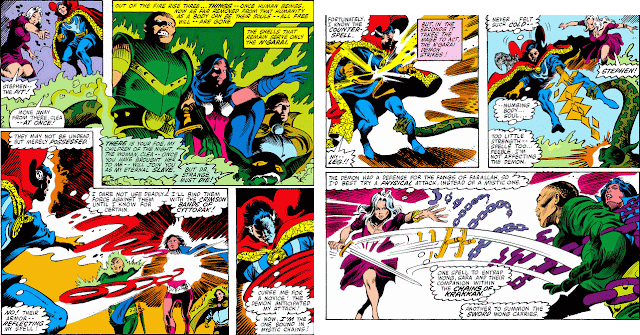Following writer Steve Englehart's departure from Doctor Strange, how curious it was to experience the revolving door of writers and artists which shuffled creative talent in an apparent effort to keep the book afloat while hopefully at some point landing on the right mix that would stabilize and continue providing direction for the character (or at least that was how things seemed from a reader's perspective). Eventually, that stability would materialize when Roger Stern took the writing reins of the book in mid-1981--but until then, it was interesting to open an issue and see just what was thrown together in terms of a coherent plot, as well as which writer and/or artist(s) were brought on board for who knows how long a stay.
Consecutively by issue, we were greeted with:
(listed in order of writer/artist(s))
- Marv Wolfman/Alfredo Alcala
- Roy Thomas/Dan Adkins (reprinting Doctor Strange #169, though you wouldn't know it by the cover that didn't get that memo)
- Marv Wolfman/Rudy Nebres
- Marv Wolfman/Jim Starlin, Rudy Nebres
- Jim Starlin/Al Milgrom, Rudy Nebres (a nice do-si-do from the previous issue by Starlin)
- Jim Starlin/Al Milgrom, Pablo Marcos
- Jim Starlin/Jim Starlin (layouts), Rudy Nebres
- Roger Stern/Tom Sutton, Ernie Chan (3 consecutive issues)
- Roger Stern/Tom Sutton
- Roger Stern/Ricardo Villamonte, Tom Sutton
- Roger Stern/Alan Kupperberg, Rudy Nebres
- Ralph Macchio (continuing Stern's plot)/Tom Sutton, Rudy Nebres
- Ralph Macchio/Tom Sutton, Craig Russell
- Ralph Macchio/Tom Sutton, Pablo Marcos
- Ralph Macchio/Gene Colan, Dan Green
In addition, we saw shuffling among the letterers and colorists (Kupperberg and Alcala, for instance, filling in as letterers, the latter even lettering an issue which featured his art). Succinctly put, for a whopping nineteen issues, Doctor Strange was, to quote a certain Mrs. Gump, like a box of chocolates--you never knew what you were going to get. Doubtless, some of you were partial to some of these talents hopefully putting down roots on the book; I was impressed by Sutton's work with the character, though I felt the Starlin/Nebres art team was regrettably too brief. Many have also gone on record praising the work of Nebres, who does excellent solo work--while Stern's footprint was obviously enough to interest him and/or the book's editors (Jo Duffy and Al Milgrom, either separately or together) in a more prolonged run.
 But before Stern would return, this time as the book's regular scripter, writer Chris Claremont would helm eight issues of Doctor Strange with artists Gene Colan and Dan Green, a fit which might have understandably shown promise given Claremont's penchant for character development. Yet his work was somewhat hampered by his decision to recycle Englehart's exploration of Strange's lack of self-confidence, a storyline which Englehart had already successfully resolved and put to bed--nor were Claremont's adversaries for Strange (the Shadowqueen... Azrael, a pawn of Mordo... a crossover with the Man-Thing... a pair of Indian demons) particularly engrossing.
But before Stern would return, this time as the book's regular scripter, writer Chris Claremont would helm eight issues of Doctor Strange with artists Gene Colan and Dan Green, a fit which might have understandably shown promise given Claremont's penchant for character development. Yet his work was somewhat hampered by his decision to recycle Englehart's exploration of Strange's lack of self-confidence, a storyline which Englehart had already successfully resolved and put to bed--nor were Claremont's adversaries for Strange (the Shadowqueen... Azrael, a pawn of Mordo... a crossover with the Man-Thing... a pair of Indian demons) particularly engrossing.Oddly enough, however, Claremont's farewell issue proved to be fairly interesting, offering what would turn out to be a one-two punch on his part featuring the return of the N'Garai (the second punch being delivered just a month later in an Uncanny X-Men story) as well as some exploration of Clea's status as Strange's disciple. But the issue's opening page reveals another kind of adversary whom Strange must contend with--an opportunist who could discover the danger of digging too deeply into the background of a man who considers his vocation and privacy sacrosanct.
If the Daily Globe rings a bell with you, you could be remembering the tabloid by way of Barney Bushkin, its former picture editor who Peter Parker approached to sell photos taken of a battle involving the Crime-Master and the Green Goblin. At this point in time, Jack Starrett is its Circulation Manager (later succeeded by the sleazy Rupert Dockery), and, while of course presenting Strange with no physical threat, is in his own way a force to be reckoned with.
To gather his information on Strange, Starrett has been keeping him under surveillance by employing the usual sort of hirelings who have no scruples about digging up dirt on others. While Strange has been meeting with Starrett, one of those has conned Strange's manservant, Wong, into gaining entry to his sanctum--only to see both himself and Wong fall victim to another visitor who shouldn't be there. It's a deadly encounter that also later draws in Sara Wolfe, Strange's social secretary.
Meanwhile, following an unsettling lunch that led to a public scene, Strange and his disciple/lover, Clea, retire to Central Park, as Clea attempts to explain why she fears she may not be suitable for the former role.
It's a valid subject for Claremont to pursue, since Clea has never had the luxury of being featured in the same light as Strange during his own time as disciple to the Ancient One--that is, making her way on her own two feet and carving out her own life and evolution as a sorcerer away from the shadow of her mentor, a man still in his prime and able to take the lead in staving off any sorcerous threat or challenge. She is also alien to this world, often overwhelmed by its people and its differences from her own. It's all well and good to see her progress within the controlled and insulated environment of Strange's sanctum--but she needs to assert herself in a major way if she's to become a vital character in this book, in addition to being a vital aide to Strange. You'd think that would be right up Claremont's alley, wouldn't you? And yet, how gratifying to see that his answer wasn't to have Clea grow more cocky by the day or develop hidden ninja skills.
On their return home, however, the unexpected presence of Starrett distracts from the threat that awaits both disciple and master.
With Claremont's departure from the book with this issue, he'll be unable to have Strange follow up on just how the N'Garai, of all entities, were able to penetrate his Sanctum with no warning signs whatsoever, though in the comics world that's often the status quo; at times Strange's mystic security measures mimic the failings of those in the Baxter Building or Avengers Mansion.
As we can see, the N'Garai demon has not only taken as hostage Wong and Starrett's hireling, but also Sara and now Clea. And considering the doubts Clea has been harboring concerning her worth as Strange's disciple, the timing couldn't be worse.
The demon of the N'Garai is a credible threat for Strange in its own right--but compounded by the fact that there are three innocents in its cold grip, its threat is magnified. Imagine, then, how the stakes are raised when the demon transforms those it holds into mystic threats who now advance on their targets.
Considering the odds that Clea faces in her current state, Strange's decision to have her guard his helpless form is a testament to his faith in her (though, granted, he really has no other choice left to him). As for the N'Garai, its inaction is perhaps to accommodate that choice as well as Strange's absence for the sake of the story, since it's doubtful that the demon would simply be content to remain motionless in its "sa'arpool" and fail to directly take advantage of the situation. Even if Clea were able to do otherwise, she can only go so far in defending herself against the demon's three thralls--why not take a two-pronged approach and act to deal with Strange's body while she's vulnerable to attack from the others?
Above, Strange encounters the busybody, Starrett, who isn't a hindrance but remains a pest--one that Strange hasn't the time to address, considering the danger that he races to avert.
For such an obscure spell that Strange is only somewhat familiar with, its length and cadence appear no more complicated or extensive to recall than any of the other incantations that he's been able to memorize--even less so, in fact. (But never having been a disciple, or even an acolyte, what do I know.)
At any rate, that does it for this demon of the N'Garai--leaving those souls who escaped its vile embrace to pick up the pieces.
And even the battle's incredulous witness is forced to concede that Strange and the world he operates in are far more than he or his readers are prepared to cope with.
As for Clea, it's a fair (and reasonable) place that Claremont leaves her in: still uncertain as to her suitability to do credit to the role she's taken on, but buttressed by Strange's faith in her to rise to the heights that he envisions for her. And the fringe benefits of the position don't hurt, either.
 | Doctor Strange #45 Script: Chris Claremont Pencils: Gene Colan Inks: "Diverse" Hands* Letterer: Jim Novak |
*Including, would you believe: Dan Green (pp. 1-6), Walt Simonson (p. 7), Al Milgrom (pp. 8, 16-17), Wendy Pini (p. 9), Frank Giacoia (p. 10), Josef Rubinstein (pp. 11-14), Bob Wiacek (p. 15), and Tom Palmer (pp. 18-22).




















2 comments:
I didn't have any complaints as a young lad, but today when I re-read old comics by Claremont, it often hits me like high school fanfic. This tale appears pretty solid, though. But then, if this is in the same era when the X-Men first face the N'garai, then Claremont was doing his best stuff around now.
It's odd to read these old comics concerning the Sanctum Sanctorum. Back then, it was a building with magic defenses. As you rightly say, defenses about as effective as those on the Baxter Building and Avengers Mansion. Wong was an Asian Jarvis- just a human caretaker and servant with a smattering of martial arts skill (because, hey, he's Asian).
In modern times, Wong has grown to be a red hot martial artist with a spooky vibe all his own. No powers, as such, but an occult savvy dude to send a shiver of uncertainty down a visitor's spine.
And the Sanctum is now a mystic maze, a sorcerous "TARDIS", with rooms and passages designed by Escher. Trespassers without the right level of arcane training or lacking occult senses do not fare well. Visitors welcomed by Wong and Strange, of course, see a stately old home. Which expands the mythos of the building while still allowing old stories where the Defenders hung out there.
A final note in my early morning ramble: I was somewhat surprised that Clea still had such doubts and limitations. The Silver Dagger/Unreality saga had that moment in the grand finale where Clea finds the power coming more easily. Apparently even that boost still left her in the kiddy pool.
One of the problems with Dr. Strange stories is that he had such a bland supporting cast. Wong seems to spend more time telling people that the Doc is out than anything else. Clea is a leftover from Stan's early days, when he really couldn't write women, who never got a personality herself. She was either the damsel in distress or someone to lay some exposition onto.
Post a Comment